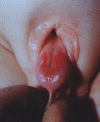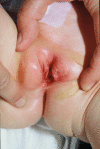The exstrophy-epispadias complex
- PMID: 19878548
- PMCID: PMC2777855
- DOI: 10.1186/1750-1172-4-23
The exstrophy-epispadias complex
Abstract
Exstrophy-epispadias complex (EEC) represents a spectrum of genitourinary malformations ranging in severity from epispadias (E) to classical bladder exstrophy (CEB) and exstrophy of the cloaca (EC). Depending on severity, EEC may involve the urinary system, musculoskeletal system, pelvis, pelvic floor, abdominal wall, genitalia, and sometimes the spine and anus. Prevalence at birth for the whole spectrum is reported at 1/10,000, ranging from 1/30,000 for CEB to 1/200,000 for EC, with an overall greater proportion of affected males. EEC is characterized by a visible defect of the lower abdominal wall, either with an evaginated bladder plate (CEB), or with an open urethral plate in males or a cleft in females (E). In CE, two exstrophied hemibladders, as well as omphalocele, an imperforate anus and spinal defects, can be seen after birth. EEC results from mechanical disruption or enlargement of the cloacal membrane; the timing of the rupture determines the severity of the malformation. The underlying cause remains unknown: both genetic and environmental factors are likely to play a role in the etiology of EEC. Diagnosis at birth is made on the basis of the clinical presentation but EEC may be detected prenatally by ultrasound from repeated non-visualization of a normally filled fetal bladder. Counseling should be provided to parents but, due to a favorable outcome, termination of the pregnancy is no longer recommended. Management is primarily surgical, with the main aims of obtaining secure abdominal wall closure, achieving urinary continence with preservation of renal function, and, finally, adequate cosmetic and functional genital reconstruction. Several methods for bladder reconstruction with creation of an outlet resistance during the newborn period are favored worldwide. Removal of the bladder template with complete urinary diversion to a rectal reservoir can be an alternative. After reconstructive surgery of the bladder, continence rates of about 80% are expected during childhood. Additional surgery might be needed to optimize bladder storage and emptying function. In cases of final reconstruction failure, urinary diversion should be undertaken. In puberty, genital and reproductive function are important issues. Psychosocial and psychosexual outcome depend on long-term multidisciplinary care to facilitate an adequate quality of life.
Figures
References
-
- Gearhart JP. The bladder exstrophy-epispadias-cloacal exstrophy complex. In: Gearhart JP, Rink RC, Mouriquand PDE, editor. Pediatric Urology. Chapter 32. Philadelphia: W. B. Saunders Co; 2001. pp. 511–546.
Publication types
MeSH terms
LinkOut - more resources
Full Text Sources






